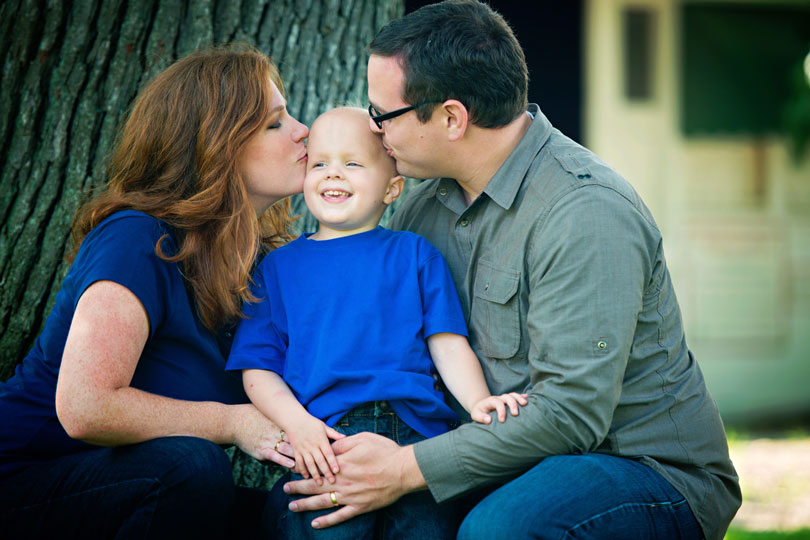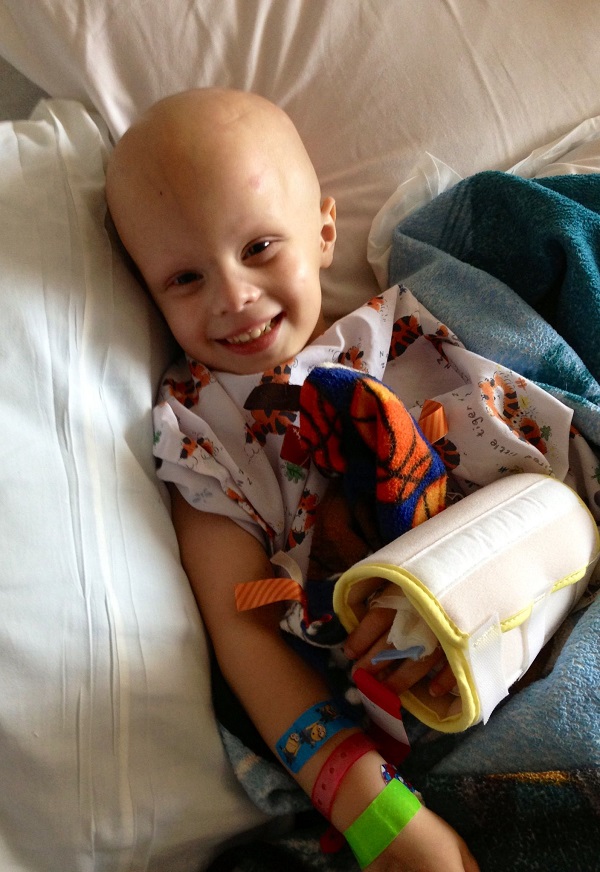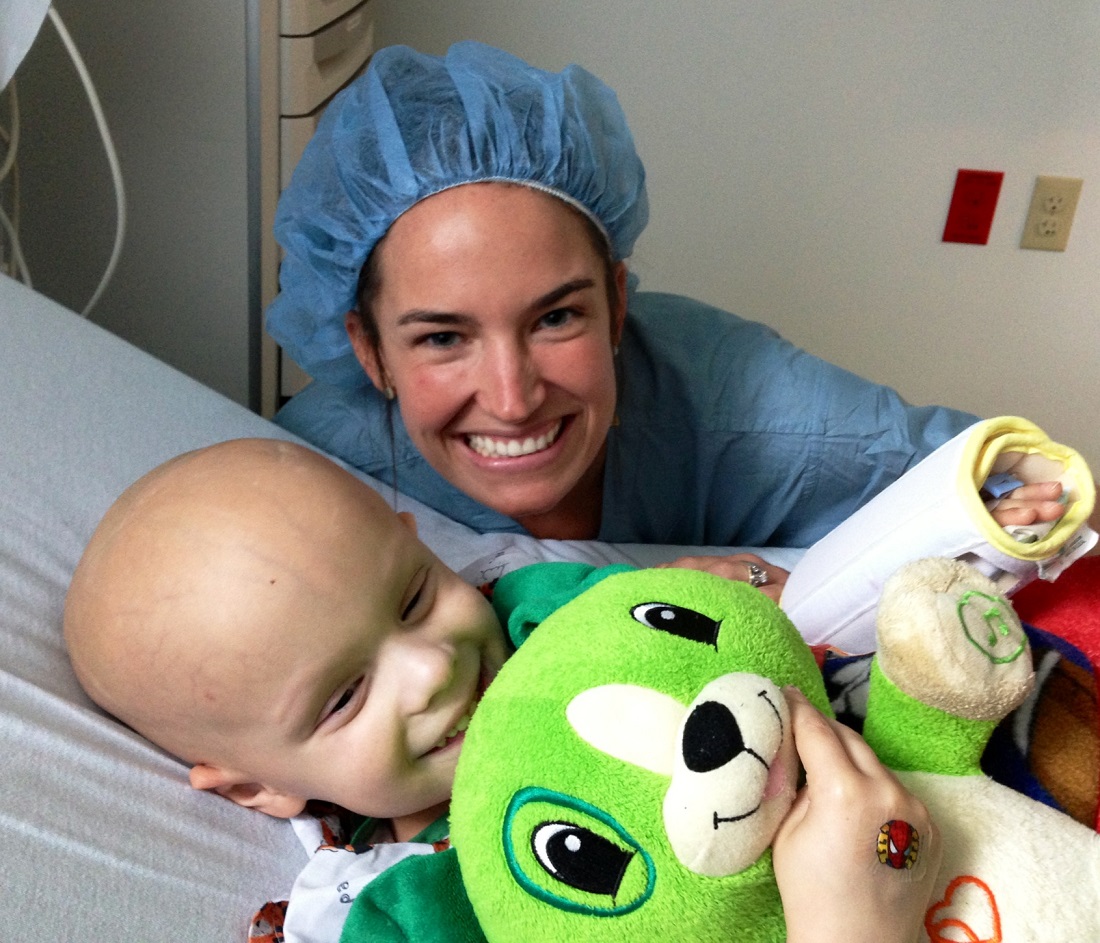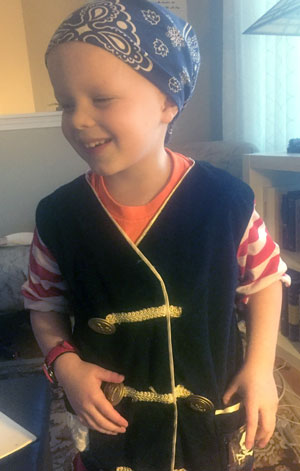Earlier this month, Chase went for a neuropsychology evaluation. His mom, Ellie, explains the events leading up to it, the news that stunned them, and how they plan to navigate the lasting effects of his brain tumor.

Chase smiles with his parents, Ellie and Bob.
As he stood before me, he nodded somewhat unwillingly. “OK, fine. Just one picture.”
Chase was going to “his hospital,” and he was going as a pirate. Because nothing says “this is who I am” like a pirate costume.
Occasionally, I drop hints in my writing about Chase’s aggression. I have trouble doing much more than that for several reasons. I think mostly because there is rarely any redemption or beauty that would benefit you from reading about it in greater detail.
It is sad and ugly and Chase is deeply ashamed of it. Whenever we talk about what happened during his angry moments, he dissolves into genuine tears, promising never, ever to do it again.
Learn about childhood cancer >
And so, there has become this other quiet side to our lives that in some way seems less real because I don’t write or talk about it the same as I do other facets. And yet, it is extremely real and taxing in our home and on our family.
Over the years, Bob and I have experienced shock and judgement on the occasions when Chase’s struggle rears its head in public.
And over the years, as people have witnessed the struggle in hospital and out, we’ve been told that we as parents were overindulgent and we must be spoiling him.

Chase was diagnosed with ATRT, a type of brain cancer in children, when he was 2.
That he needed more control over life choices.
That we were giving him too many choices.
That we weren’t treating him normally.
That we were treating him too normally.
That the anger was his reaction to the out-of-control-ness of life in childhood cancer treatment.
That it might be the anti-seizure medication he takes every day.
That it stemmed from anxiety.
That we needed to change his diet.
That we needed to change his supplements.
That we needed to change his environment.
That it could be circumstantial.
And various other things.
BLOG: 5 Facts About Childhood Cancer Survivors >
We’ve thought many times about getting help for him, but weren’t even sure what “help” should look like or who should provide it. We were often told that he was too young and his brain was still developing too much for anything to be of assistance.
We were even told at one point that some specialists had no paradigm for a child who’d been through the extreme brain and emotional trauma that Chase had experienced.
It was as if everybody knew on some level that it was happening, but nobody knew how to deal with it or what was at its root. A very isolating feeling.
Hearing that it was something we were doing was especially difficult. In the first week that Chase was diagnosed, Bob and I had determined that one of the very best gifts we could give him was the gift of normal. His life had become extraordinary and we desired to keep that out of his way as much as we could. And so, we instituted loving boundaries in and around the chemo and treatment.
How do you give a “time out” to a child whose life is a giant hospital bed punishment? You can’t… but maybe if a toy got thrown in anger, then the toy went into time out for a few minutes. Small things like that — the things that made him like his brothers and sister, like the other kids outside the hospital walls.
But it was a constantly changing situation in which we were (and still are) always having to weigh what’s chemo damage, what’s tumor damage, and what’s Chase.

Chase with one of his nurses before a port surgery.
Despite our efforts, the rages continued unchecked. We felt like we were doing everything good parents were supposed to do. How was this our fault?
We plunged forward and fought these fights every week and sometimes every day. And yet, we’ve felt largely unheard. Not because anybody’s ignoring us, but because I truly believe that the pediatric cancer survivor field is still significantly unfolding in this area.

Chase in his pirate costume before heading to his neuropsychology exam.
Think about it: Chase’s cancer has only been defined by name for about 20 years. And it’s only been about seven since his treatment began as a clinical trial, changing statistics from completely terminal to marginally terminal. And suddenly, Chase’s generation of survivors are living long enough to really see what happens after the dust settles.
Some days, our lives feels like the cancer equivalent of the old Oregon Trail — where we just circle up the wagons and try to survive.
Bob and I often liken Chase and his treatment to a house fire. When he was rushed in with his large mass, he was a house consumed. The teams of doctors were almost like teams of fire fighters, working collectively to extinguish the deadly blaze on all levels. You do what you have to do to save.
And then we were done and thankful… But, who helps rebuild the house? You can’t expect the firefighters to do that for you.
This is ultimately what led to Chase going to the hospital as a pirate this cold winter morning. We were on a search for builders — master builders. It was time to work at rebuilding, and Chase’s primary team of doctors had recommended that he was now old enough for a neuropsychology evaluation.
We were cautiously optimistic, having been warned that it may not explain his aggression, but would definitely show some of his strengths, weaknesses, and how he learned. But we could still hope. Maybe there would be something — anything — that could provide us with a clue as to how we could help him.
And so it began. Hours of testing, piles of paperwork, and then a two-hour meeting.
What we learned in the meeting was both life changing and amazing.
Learn more about the research we’re funding to help kids like Chase.
Read more about Chase:


 SBF
Tweets »
SBF
Tweets »